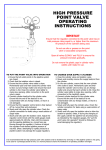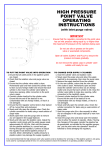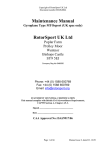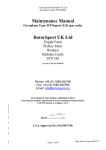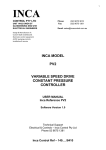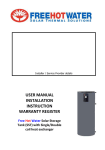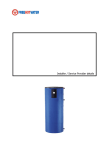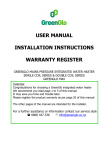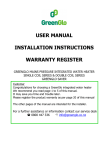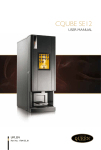Download OPERATING INSTRUCTIONS FOR COMPRESSED GAS
Transcript
OPERATING INSTRUCTIONS FOR COMPRESSED GAS REGULATORS WARNINGS Only operate this regulator if you have been trained in its proper use, or you are operating under competent supervision. Oxygen is not flammable, however, the presence of increased levels of oxygen will drastically increase the speed and force with which burning takes place. Oxygen and oxidising gases must never be allowed to contact oils, greases or other combustible contaminates. Therefore use no oils, greases or unapproved substances on the regulator, cylinder valve or downstream equipment. Do not use this regulator with gases other than those for which it is intended. Do not use this regulator unless you are familiar with the hazards associated with the gases you are using. Always open cylinder valves slowly to minimise possible dangers caused by rapid pressurisation of the regulator. Always pressurise the system downstream of any regulator slowly in a controlled manner. This is particularly important for gases such as helium and hydrogen. Do not allow the regulator to free flow gas to atmosphere without any back pressure. Consideration should be given to remotely venting the exhaust of pressure relief valves if the regulators are operated in areas that are not well ventilated area. This is especially important for fuel gases, toxic gases and asphyxiant gases. Setting up Equipment. 1. Secure cylinder to wall, stand or trolley so it will not tip over or fall. 2. Remove the protective dust seal from the cylinder valve. 3. Inspect the cylinder valve for damaged threads, traces of dirt, dust, oil or grease. NOTE: If oil or grease is detected, DO NOT use cylinder. Inform your gas supplier of this condition immediately. 4. With the cylinder valve outlet pointing away from people and sources of ignitions, “crack” the cylinder by momentarily opening and closing the cylinder valve. Always “crack” fuel gas cylinders in a well ventilated area. Do not “crack” cylinders of toxic or corrosive gases. Fitting the Regulator. 1. Make sure the regulator has the correct inlet fitting to fit the cylinder valve. Check the fitting for any damaged threads. If the fitting is so equipped, make sure the flat sealing washer or oring is in place between the regulator and the cylinder valve outlet. The threads may be either right hand or left hand depending on the gas being used. Regulator inlet connections with left hand threads have a “V” notch machined into the hex to signify a left hand thread. 2. Tighten the regulator inlet nut securely with a spanner, or hand tighten if the regulator has a medical yoke T-screw. 3. Connect the downstream equipment to the regulator outlet fitting. Turning on the Cylinder. 1. Be sure that the adjusting knob of the regulator (adjustable models) is fully “backed-off” (ie. fully counter clockwise). For preset pressure regulators ensure that the downstream equipment is fitted to the outlet connection and its control valve is turned off. Stand in a position so the cylinder valve is between you and the regulator. NOTE: For greater safety never stand in front of a regulator when opening the cylinder valve. Slowly turn the cylinder valve on in a counter clockwise direction until you hear the gas begin to flow into the regulator. Wait about 10 seconds then proceed to fully open the cylinder valve. 2. To check for leaks, close the cylinder valve and observe the high pressure gauge for 5 minutes. If the high pressure gauge reading drops, there is a gas leak in the cylinder valve, inlet fitting, high pressure gauge or regulator seat. Retighten the regulator to cylinder connection and repeat step 1. Should the high pressure gauge continue to drop after retightening, the regulator must be removed and returned for servicing. Adjusting Regulator Delivery Pressure. 1. After the regulator has been securely attached to the cylinder valve, adjust the delivery pressure by turning the adjusting knob in a clockwise direction until the required pressure is reached. 2. If the regulator is equipped with a flow control valve or flowmeter, flow can be controlled by proper adjustment of the valve/flowmeter. Turning Off Cylinder Valve. 1. When you have finished using the regulator, close the cylinder valve off in a clockwise direction and allow the regulator to de-pressurise. The pressure has been released from the regulator when gas ceases to flow and the pointers on both pressure gauges indicate zero. 2. After all pressure has been released from the regulator, release the tension on the regulator adjusting knob by turning it fully counter clockwise. Removing the Regulator. 1. It is not necessary to remove the regulator unless the cylinder is being moved, or an empty cylinder is being replaced. 2. NEVER attempt to remove the regulator if any pressure is showing on either pressure gauge. If pressure is showing, follow the “Turning Off Cylinder Valve” procedure described previously. 3. Remove the regulator from the cylinder and replace the protective cap on the cylinder. 4. Place the regulator in a secure place to avoid damage and contact with oils, greases, dust or any other possible contaminants. COMMONLY ASKED QUESTIONS AND MISTAKES ABOUT GAS REGULATORS Q. A. Is my brass body regulator OK for ultra high purity application, or do I need a stainless steel body regulator? Brass regulators are acceptable for ultra high purity applications so long as it has a stainless steel diaphragm. Stainless steel bodies do not make regulators cleaner in regards to the gas flow. Stainless steel diaphragms are used in all high purity regulators regardless of their body material. Stainless steel body regulators are needed for corrosive gases and or harsh external environments. Q. A. If the outlet pressure gauge shows 1000kPa, why won't it deliver to 1000kPa? Regulators have springs inside that control the maximum delivery pressure possible. The pressure gauge does not dictate the maximum delivery pressure of the regulator. Most pressure gauge manufacturers do not recommended that their gauges are constantly operated at their full scale pressure. Q. A. Can I set an outlet pressure of 20kPa when the rated outlet pressure of the regulator is 800kPa? Not reliably. The regulator will actually fluctuate greatly if the rated outlet pressure is too high. It will probably allow the flow of gas, but the pressure will not be stable. As a rough guide regulators do not operate reliably at set pressures below 10% of the rated outlet pressure Q. A. Will my pressure regulator control gas flow? No. Pressure regulators control pressure not flow. A flow valve or flowmeter, in combination with a regulator, will be needed to control flow. Q. A. Why does my gas regulator hum sometimes? Regulator hum indicates that the seat and stem dampers are worn or inoperative. It is also possible that you are using an improperly ranged regulator. The regulator may need servicing Q. A. Can I use any old regulator for my application? Don't go into that drawer full of old regulators and assemble a regulator that fits. Gas cylinders fill pressures have up to significantly increased over the years. Accidentally putting an old regulator or a regulator designed for lower inlet pressure may result in a serious incident. Get the right regulator for the job or at least contact the manufacturer of the "old drawer dinosaur" and have them tell you if it will be OK for you intended application. Changing a regulator from one gas service to another without seeking advice is also risky practice. Q. A. Do I need to use Teflon tape on the cylinder valve to regulator connection? No, all cylinder connections are designed to connect without the use of Teflon tape. Some connections use flat washers or o-rings, but a lot of connections use metal-to-metal contact to form a leak free connection. The use of Teflon tape is not necessary. Q. A. How tight should my cylinder connection be? Tight enough not to leak. If the connection keeps leaking, check for damage to the face of the inlet fitting or debris in the cylinder valve connection. A sealing washer or o-ring could be missing as well. Do not use multi-grip pliers to tighten the inlet connection. It will ruin the nut and most likely leak, thus requiring the regulator to be repaired. Q. A. When I turn the knob counter-clockwise (reduce pressure) on my regulator the delivery pressure does not change? Most laboratory regulators are designed to be non-self relieving. The regulator will not reduce its delivery pressure unless the gas is flowing through the regulator. If the downstream segment of the system is static, the pressure will not drop unless you vent the system. However, the pressure will increase if you dial in a higher pressure when the system is static. Q. If I have to fit a new outlet fitting to the regulator should I use some form of thread sealant? A. Yes. The majority of regulators use ¼”NPT threaded connections which require a form of sealant. Oxygen cleaned virgin Teflon tape that has a green tint is the recommended sealant. It is not recommended to use other types of Teflon tapes (ie. white=plumbers, pink=water, yellow=natural gas), Teflon pastes, Loctites or other products without approval from the manufacturer. Q. Does my regulator require any maintenance or servicing? A. Yes. Like all pieces of equipment a gas regulator should be periodically inspected/tested and serviced. As a minimum, regulators should be checked for obvious damage, external leaks and pressure control performance annually. Contact the manufacturer for further information. Q. Gas is flowing out of the pressure relief valve on my regulator, what should I do? A. There is a problem with the regulator, remove it from cylinder valve and seek further advice about have it tested and/or serviced. Do not attempt to fix the problem by removing, capping the outlet or increasing the setting of the pressure relief valve. Q. How do I connect the outlet of the regulator to my equipment? A. There are many different ways of connecting the regulator to downstream equipment. Some of the more common methods are: 1. Compression fittings – they are usually either brass or stainless steel and are designed for connecting metal piping/tubing, (eg copper or stainless steel), to the regulator outlet. Brass compression fittings must not be used on stainless steel tubing. Some manufacturers make special plastic tubing for use with compression fitting, but these have much lower maximum working pressure than metal piping/tubing. 2. Rubber type hoses – these are very flexible but have limitations on their maximum working pressure. They usually connect using a nut and nipple connection on the hose and a matching fitting on the regulator. Because of the wide range of rubber hoses available, the material compatibility of the hose with the working gas may need to be considered. Q. Can I accidentally connect my downstream equipment to something other than the regulator outlet connection? A. Yes, it is possible on some regulators. Sometimes people can accidentally connect their equipment to the outlet of the pressure relief valve instead of the regulator outlet. The outlet connection should usually be stamped “LP” or “OUT”. The outlet connection should normally be next to the outlet pressure gauge. If the regulator has a plastic plug screwed into the main body, then that should the outlet connection. REGULATOR MAIN COMPONENTS


